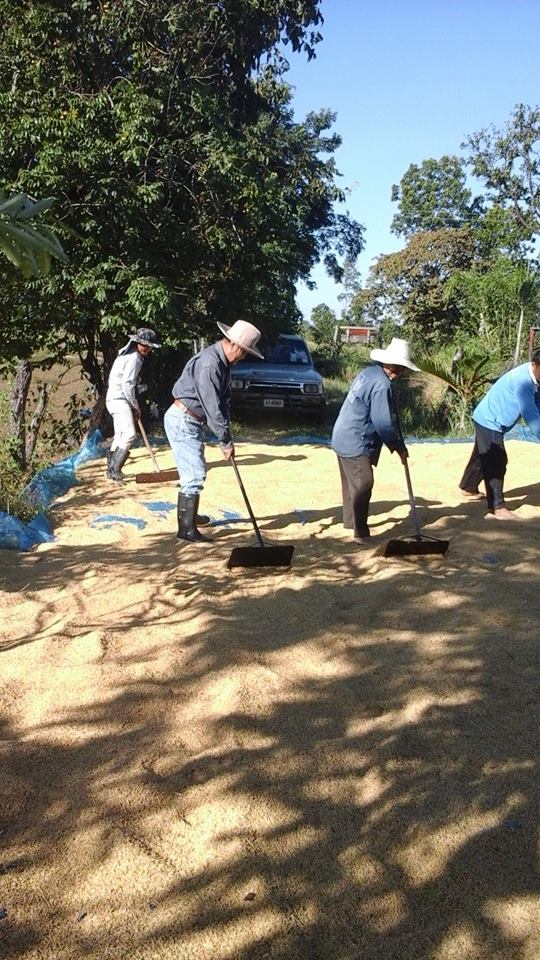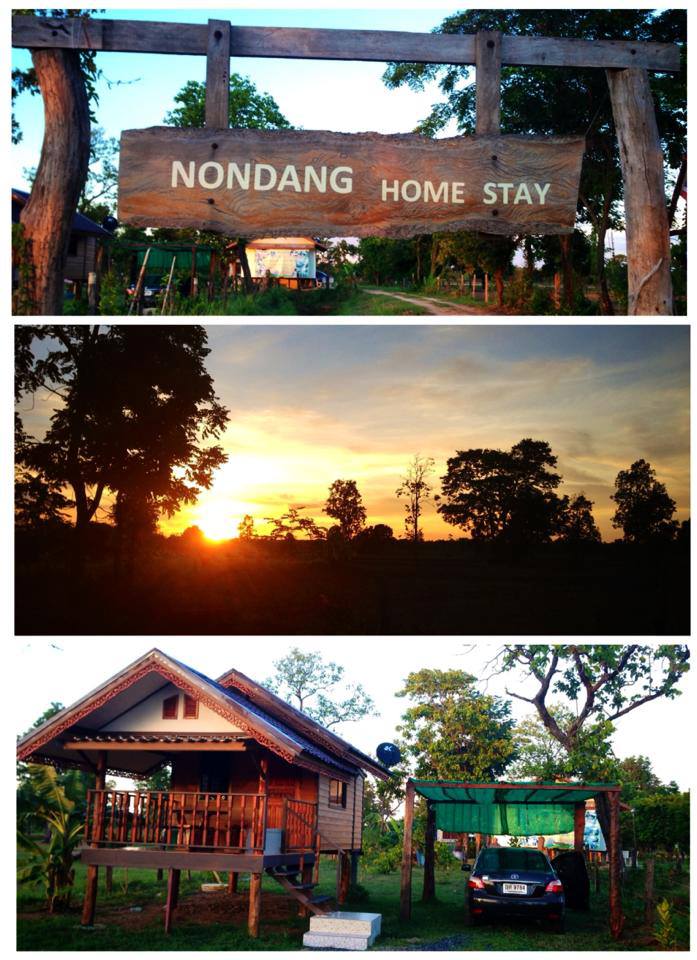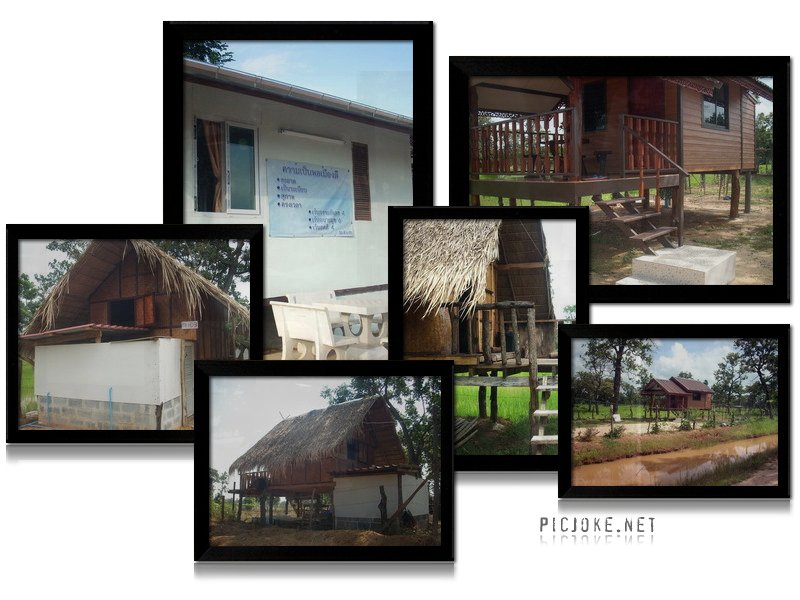วิถีชีวิตชาวบ้านนาโนนแดง.(Lifestyle ‘s Nondang)
สถานที่แห่งนี้จะทำให้คุณได้รู้จักวิธีปลูกข้าวตามฤดูกาล ตั้งแต่ขั้นตอนแรกของการปลูกข้าว การเตรียมดิน ไถดิน ปลูกต้นกล้า เก็บเกี่ยว และนี่ก็คือที่มาของข้าวคุณภาพดีจากนาโนนแดงโฮมสเตย์
This place will make you know how to grow rice season. Since the first stage of the crop. Tillage and planting seedlings, harvesting, and this is a source of good quality rice from na-Nondanghomestay.
![12963362_1105181802872406_1260083005129796556_n[1]](http://nondanghomestay.com/wp-content/uploads/2012/07/12963362_1105181802872406_1260083005129796556_n1.jpg)
![13001198_1105181782872408_4488033910159078373_n[1]](http://nondanghomestay.com/wp-content/uploads/2012/07/13001198_1105181782872408_4488033910159078373_n1.jpg)
ขั้นตอนการทำนา
(The process of planting rice)
1.การเตรียมพันธุ์ข้าว
เมื่อนำเมล็ดข้าวไปเพาะให้งอก โดยแชน้ำนานประมาณ 1-2 ชั่วโมง แล้วนำเมล็ดขึ้นจากน้ำและเก็บไว้ในที่ที่มีความชื้นสูงเมล็ดจะงอกภายใน 48 ชั่วโมง จึงนำเมล็ดที่เริ่มงอกเหล่านี้ไปปลูกในดินที่เปียก ส่วนที่เป็นรากจะเจริญเติบโตลึกลงไปในดิน ส่วนที่เป็นยอดก็จะสูงขึ้นเหนือผิวดินแล้วเปลี่ยนเป็นใบ ต้นข้าวเล็กๆนี้เรียกว่า ต้นกล้า หลังจากต้นกล้ามีอายุ ประมาณ 40 วัน จะมีหน่อใหม่เกิดขึ้นโดยเจริญเติบโตออกจากตา บริเวณโคนต้น ต้นกล้าแต่ละต้นสามารถแตกหน่อใหม่ประมาณ 5-15 หน่อ ทั้งนี้ขึ้นอยู่กับพันธ์ข้าว ระยะปลูก และความอุดมสมบูรณ์ของดิน แต่หน่อต้นกล้าให้ร่วงข้าวหนึ่งรวง แต่รวงข้าวมีเมล็ดข้าวประมาณ 100-200 เมล็ด โดยปกติต้นข้าวที่โตเต็มที่แล้วจะมีความสูงจากพื้นดินถึงปลายรวงที่สูงที่สุดประมาณ100-200 เซนติเมตรซึ่งแตกต่างไปตามพันธุ์ข้าวตลอดจนถึงความอุดมสมบูรณ์ของดินและความลึกของน้ำ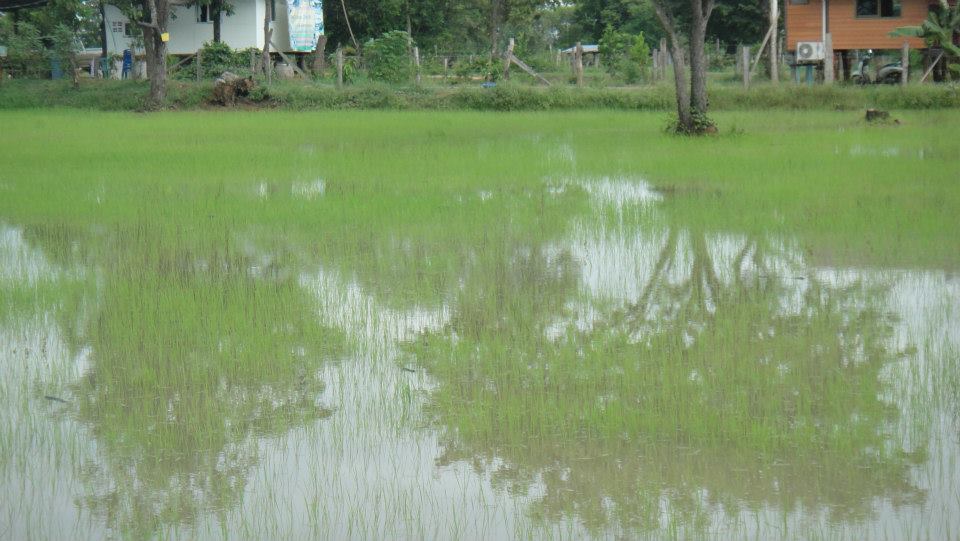
- Prepare rice
When the grain cultured to regenerate. The water for about 1-2 hours. Then the beans from the water and stored in a damp seeds will germinate within 48 hours. The seeds that germinate these were planted in wet soil. The roots grow deep into the soil. The crowning will rise above the surface and change the blade. Rice called this tiny seedling after seedling age. 40 days New shoots will occur by growth from buds near the base of each tree seedlings to sprout new shoots 5-15. Depending on the species, rice planting and soil fertility.
But one bud seedlings to rice grains. The rice grains are 100-200 seeds. Typically, the crops mature to a height from the ground to the ears of the tallest about 100-200 centimeters, which varies according to the rice along with the fertility of the soil and the water depth.
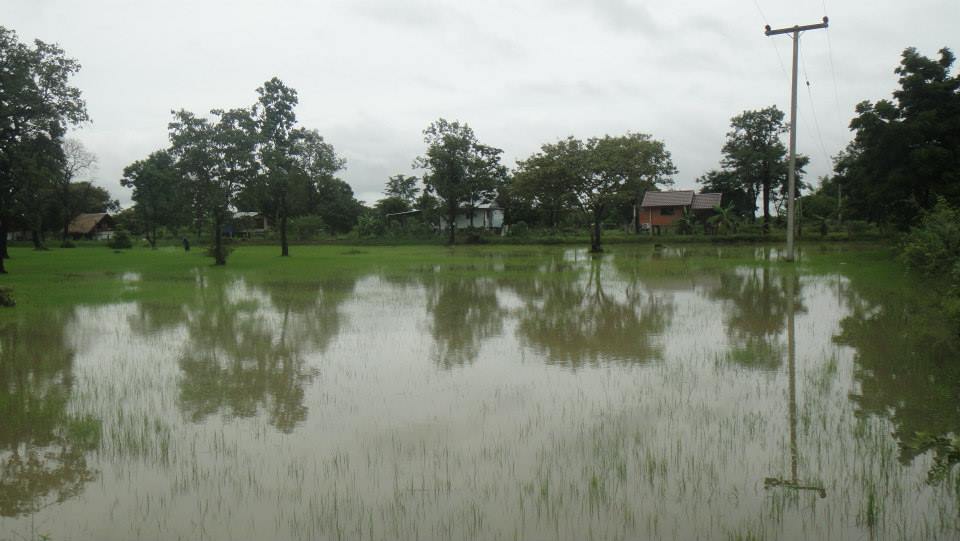
2.การปลูกข้าว
วิธีการปลูกข้าวหรือการทำนาในประเทศไทยแบ่งออกเป็น 3 วิธี ดังนี้
2.1 การปลูกข้าวไร่ หมายถึง การปลูกข้าวบนที่ดอนไม่มีน้ำขังในพื้นที่ปลูกชนิดของข้าวที่ปลูกเรียกว่า ข้าวไร่ พื้นที่ดอนส่วนมาก เช่น ภูเขา มักจะไม่มีระดับ คือ สูงๆต่ำๆ จึงไม่สามารถไถเตรียมดิน และปรับระดับดินได้ง่ายๆ เหมือนกับพื้นที่ราบ เพราะฉะนั้นชาวนามักปลูกข้าวแบบหยอด โดยขั้นแรกทำการตัดหญ้าและต้นไม้เล็กออก แล้วจึงทำความสะอาดพื้นที่ที่จะปลูก แล้วใช้หลักไม้ปลายแหลมเจาะดินเป็นหลุม ปกติจะต้องหยอดพันธุ์ข้าวทันทีหลังจากที่เจาะหลุม และหลังจากหยอดเมล็ดพันธุ์ข้าวแล้วจะใช้เท้ากลบดินปากหลุม เมื่อฝนตกหรือเมื่อเมล็ดได้รับความชื้นจากดิน เมล็ดจะงอกและเจริญเติบโตเป็นต้นข้าว เนื่องจากที่ดอนไม่มีน้ำขังและไม่มีการชลประทาน การปลูกข้าวไร่จึงต้องใช้น้ำฝนเพียงอย่างเดียว พื้นที่ปลูกข้าวไร่จะแห้งและขาดน้ำทันที่เมื่อสิ้นหน้าฝน ดังนั้นการปลูกข้าวไร่จึงต้องใช้พันธุ์ที่มีอายุเบา โดยปลูกในต้นฤดูฝนและแก่เก็บเกี่ยวได้ในปลายฤดูฝน ดังนั้นการปลูกข้าวไร่ ชาวนาจะต้องหมั่นกำจัดวัชพืช เพราะที่ดอนมักจะมีวัชพืชมากกว่าที่ลุ่ม พื้นที่ที่ปลูกข้าวไร่ในประเทศไทยมีจำนวนน้อยและปลูกมากในภาคเหนือและภาคใต้ ส่วนภาคตะวันออกเฉียงเหนือและภาคกลางปลูกข้าวไร่น้อยมาก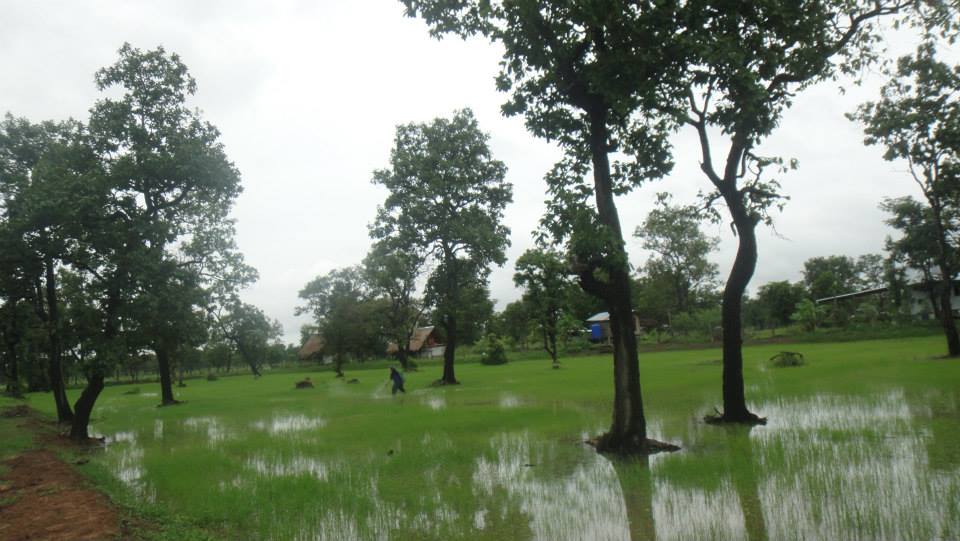
2.2 การปลูกข้าวนาดำ หรือเรียกว่า การปักดำ ซึ่งวิธีการปลูกแบ่งเป็นสองตอน ตอนแรกได้แก่การตกกล้าในแปลขนาดเล็ก และตอนที่สองได้แก่การถอนต้นกล้านำไปปักดินในนาผืนที่ใหญ่ ดังนั้น การปลูกแบบปักดำอาจเรียกว่า Indirect Seeding ซึ่งต้องเตรียมดินที่ดีกว่าการปลูกข้าวไร่ ซึ่งมีการไถดะ การไถแปร และการคราด ปกติการไถและคราดในนาดำมักจะใช้แรงวัวควาย หรือแทรกเตอร์ขนาดเล็กที่เรียกว่า ควายเหล็ก หรือไถยนต์เดินตาม ทั้งนี้เป็นเพราะพื้นที่นาดำมีคันนาแบ่งกั้นออกเป็นแปลงเล็กๆ ขนาดแปลงละ 1 ไร่ หรือเล็กกว่า คันนามีไว้เพื่อกักเก็บน้ำ ปล่อยน้ำทิ้งจากแปลงนา นาดำจึงมีการบังคับน้ำในนาไว้ได้บ้างพอสมควร การไถดะ หมายถึง การถครั้งแรกเพื่อทำลายวัชพืชในนาและพลิกกลับหน้าดิน แล้วปล่อยทิ้งไว้ประมาณ 1 สัปดาห์ จึงทำการไถแปรซึ่งหมายถึงการไถตัดกับรอยไถดะ การไถแปรอาจไถมากกว่าหนึ่งครั้ง ทั้งนี้ขึ้นอยู่กับระดับน้ำในนาตลอดจนถึงชนิดและปริมาณของวัชพืช เมื่อไถแปรแล้วทำการคราดได้ทันที การคราดก็คือการคราดเอาวัชพืชออกจากผืนนา และปรับพื้นที่นาให้ได้ระดับเป็นที่ราบเสมอกัน ด้วยพื้นที่นาที่มีระดับเป็นที่ราบจะทำให้ต้นข้าวได้รับน้ำเท่าๆกัน และสะดวกต่อการไขน้ำเข้าออก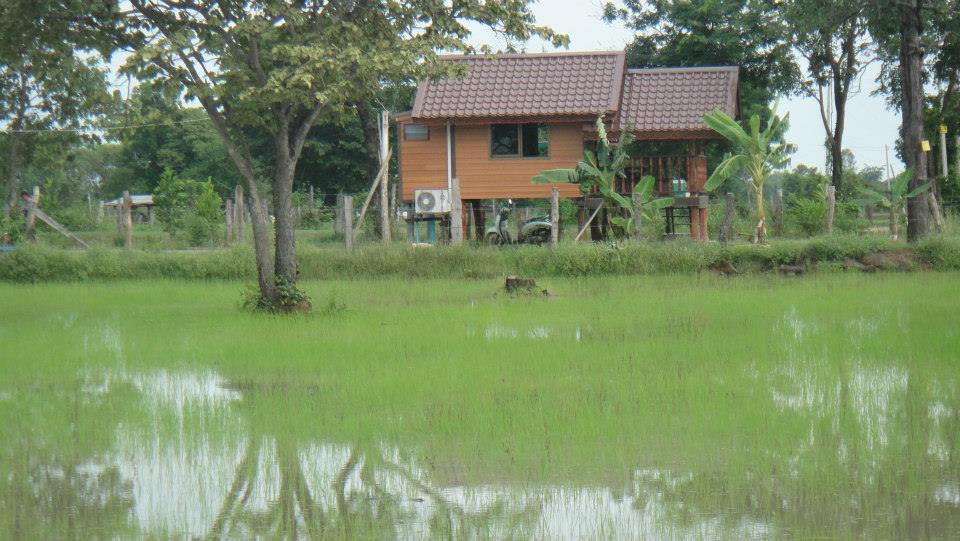
การตกกล้า หมายถึง การนำเมล็ดหวานให้งอก ใช้เวลาประมาณ 25-30 วัน นับจากวันหว่าน เมล็ดจะเจริญเติบโตเป็นต้นกล้าที่มีขนาดโตพอที่จะถอนนำไปปักดำได้
การปักดำ คือการนำต้นกล้าที่ถอนขึ้นจากแปลงแล้วมัดรวมกันเป็นมัดๆ จะต้องสลัดดินโคลนที่รากออก แล้วนำไปปักดำในพื้นที่นาที่ได้เตรียมไว้ ถ้าต้นกล้าสูงมากก็ตัดปลายใบทิ้ง พื้นที่นาที่ใช้ปักดำควรมีน้ำขังอยู่ประมาณ 5-10 เซนติเมตร เพราะต้นข้าวอาจถูกลมพัดจนพับลงได้เมื่อนานั้นไม่มีน้ำขังอยู่เลย ถ้าระดับน้ำในนั้นลึกมากต้นข้าวที่ปักดำอาจจมน้ำในระยะแรก และ ข้าวจะต้องยืดต้นมากกว่าปกติ จนผลให้แตกกอน้อย การปักดำที่ได้ผลผลิตสูงจะต้องปักดำให้เป็นแถวเป็นแนว และมีระยะห่างระหว่างกอมากพอสมควร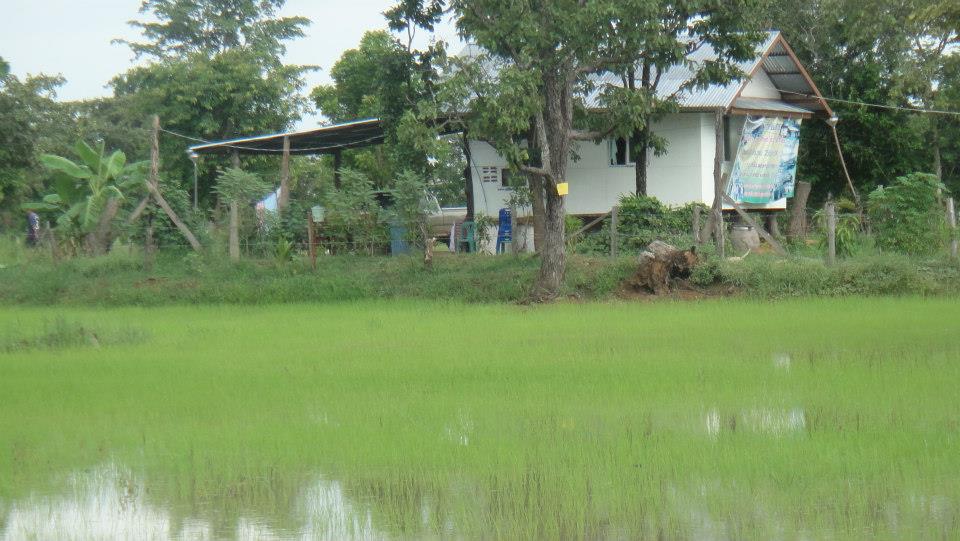
2.3 การปลูกข้าวนาหว่าน เป็นการปลูกข้าวโดยเอาเมล็ดพันธุ์หว่านลงในพื้นที่นาที่ไถเตรียมไว้โดยตรง ซึ่งเรียกว่า Direct Seedingการเตรียมดินก็คือการไถดะและไถแปร ชาวนาจะเริ่มไถนาสำหรับปลูกข้าวนาหว่านตั้งแต่เดือนเมษายน เนื่องจากพื้นที่นาสำหรับปลูกข้าวนาหว่านไม่มีคันนากั้นจึงสะดวกแก่การไถด้วยแทรกเตอร์ขนาดใหญ่ อย่างไรก็ตามยังมีชาวนาจำนวนมากใช้แรงงานวัวและควายไถนาการปลูกข้าวนาหว่านมีหลายวิธีด้วยกัน เช่น การหว่านสำรวย การหว่านคราดกลบหรือไถกลบ การหว่านหลังขี้ไถ และการหว่านน้ำตม การหว่านสำรวย การหว่านวิธีนี้ชาวนาจะหว่านเมล็ดพันธุ์ข้าวที่ยังไม่ได้เพาะให้งอกลงในพื้นที่นาเตรียมดินโดยการไถดะ และไถแปรไว้แล้วโดยตรง เมล็ดพันธุ์ที่หว่านลงไปตกลงปอยู่ในซอกระหว่างก้อนดินและรอยไถ เมื่อฝนตกพื้นดินเปียกและเมล็ดได้รับความชื้นเมล็ดข้าวจะงอกเป็นต้นกล้า การหวานวิธีนี้ใช้เฉพาะท้องที่ซึ่งดินมีความชื้นพออยู่แล้วการหว่านคราดกลบหรือไถกลบ ชาวนาจะทำการไถดะและไถแปร แล้วจึงนำเมล็ดที่ยังไม่ได้เพาะ ให้งอกหว่านลงไปทันทีแล้วคราด หรือไถเพื่อกลบเมล็ดที่หว่านลงไปอีกครั้งหนึ่ง เนื่องจากดินมีความชื้นอยู่แล้วเมล็ดจะเริ่มงอกทันทีหลังจากหว่านลงดิน การตั้งตัวของต้นกล้าจะตั้งตัวดีกว่าการหว่านสำรวย เพราะเมล็ดที่หว่านถูกกลบฝังลึกลงในดินการหว่านน้ำตม การหว่านแบบนี้นิยมใช้ในพื้นที่มีน้ำขังประมาณ 3-5 เซนติเมตร และพื้นที่นาเป็นผืนใหญ่ขนาดประมาณ 1-2 ไร่มีคันนากั้นเป็นแปลงการเตรียมดินทำเหมือนกับการเตรียมดินสำหรับนาดำ ซึ่งมีการไถดะ ไถแปร และคราดเพื่อเก็บวัชพืชออกจากพื้นนาแล้วจึงทิ้งให้ดินตกตะกอนจนเห็นว่าน้ำใส จึงนำเมล็ดพันธุ์ที่เพาะให้งอกแล้วหว่านลงนาและไขน้ำออก เมล็ดจะเจริญเติบโตเป็นต้นข้าวและเจริญเติบโตอย่างข้าวอื่นๆ ตามปกติการหว่านแบบนี้นิยมทำกันในท้องที่จังหวัดฉะเชิงเทรา ที่ทำการปลูกข้าวนาปรัง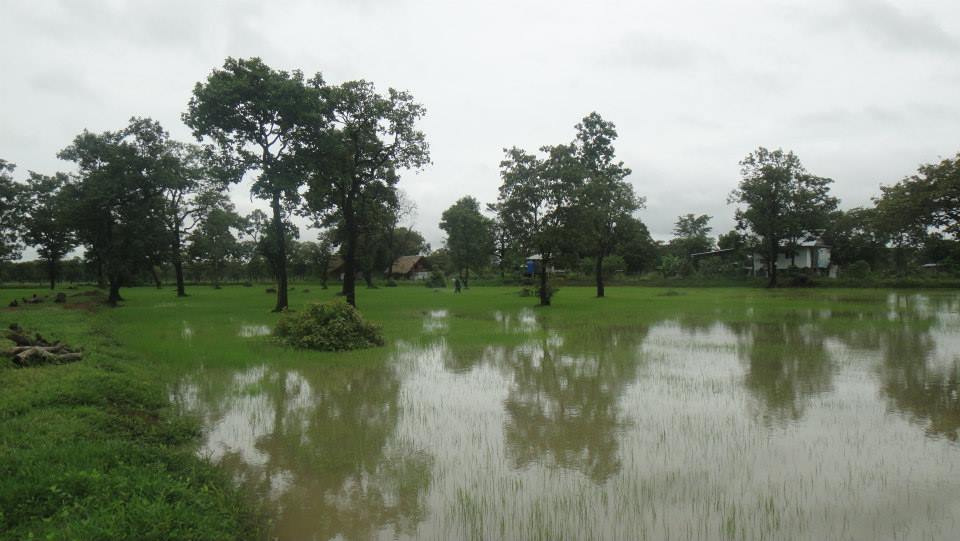
- Rice
How to grow rice or rice in Thailand is divided three ways.
2.1 hectares of rice crops means no water in the upland rice growing areas of the upland rice as the mountain is often no level rise can not plow tillage. And leveling the soil easily Unlike plains Thus, rice farmers often drops. The first step is to cut the grass and small trees. Then clean the area to be planted. Then the wood-tipped drill hole with soil. Sowing seeds usually have immediately after drilling. After sowing seeds and then take the soil from the hole. When it rains or when seeds get moisture from the soil. The seeds will germinate and grow rice. Since Don has no water and no irrigation. Rice growers had to use rainwater alone. Rice farm has dried up and dehydrated at the end of the rainy season. The upland rice varieties need to use a lighter. By planting in the rainy season and the harvest at the end of the rainy season. The upland rice Farmers will need to keep weeding The upland weeds often have more depression. The area planted to rice in a small number and grown in North and South. The Northeast region of rice fields and little more.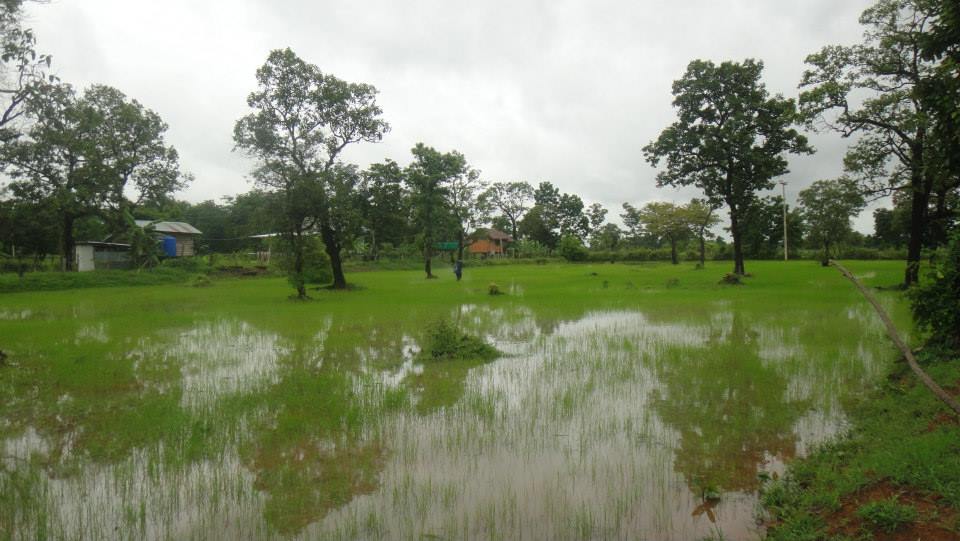
2.2 planted or transplanted rice called How to grow rice, which is divided into two sections. At first dare to fall in such a small Translation. And the second is to remove the seedlings to be planted in the soil, so the fields planting rice called Indirect. Seeding is better to prepare the ground for rice plantation. The plow roughly for the first time with a plow in regular furrows for the second time, and rake and rake in transplanted normal plowing often force cattle. Or small tractors that plow or tractor motor to follow. This is because the transplanted a levee break out into small plots. A plot of one acre or smaller. Khanna is intended to store water. Discharge from the field The transplanted in a field, forcing some to plow roughly for the first time means taking enough time to destroy weeds in the field and overturned soil. Then leave it for about one week. It will plow in regular furrows for the second time, which means plowing plow roughly for the first time cut the tracks. The plow can plow in regular furrows for the second time more than once. Depending on the water level in the field as well as the type and quantity of weeds. When the plow in regular furrows for the second time, then rake immediately. The rake is a rake to remove weeds from the farmland. And the area was not a plain tie. The area has undergone a make plain rice was water evenly. And provides easy access to the sluice.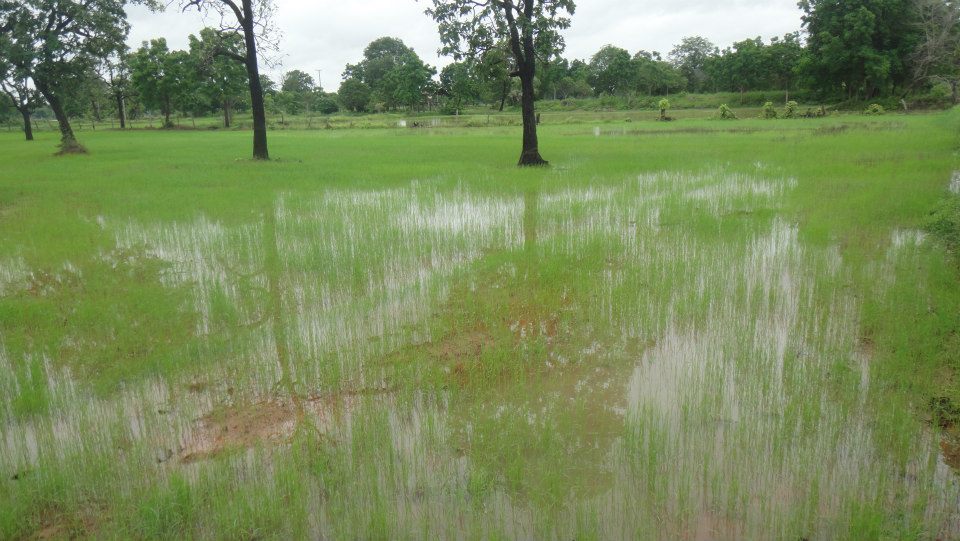
It means the fall germinated seeds sweet. It takes about 25-30 days From sowing The seeds are grown seedlings are large enough to lead to the removal of black lace.
The rice seedlings is to withdraw from the conversion and tied together in a bundle around. Must throw mud at the root out. Then the rice paddy was prepared. If the seedlings are very high, cut the leaves off. Paddy rice should be used with water for about 5-10 centimeters, because the crops may be folded down when the wind farm is no water at all. If the water level is very deep in the rice crops might drown in the early stages and crops are beginning to stretch more than normal. As a result, fewer tillers The high yield of rice will need to rice in a row. And the distance between clumps enough.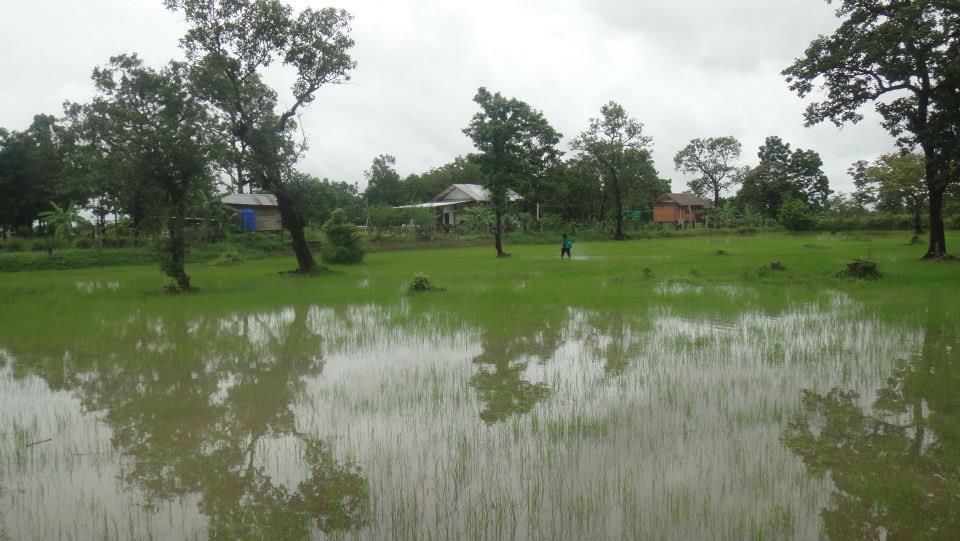
2.3 for rice sowing The rice varieties by seeds sown in a plowed field prepared directly called Direct. Seeding Soil preparation is to plow roughly for the first time and plow in regular furrows for the second time. Farmers will begin plowing for crop sowing in April. Since paddy rice for sowing no ridge so easy for plowing with tractors, large. However, there are a lot of manual labor, farmers, cattle and buffalo to plow rice is seeded in several ways, such as sowing dandy. Sowing harrow or incorporation. After sowing Kigat And sweet Slough sowing dandy. This way, farmers will sow to sow seeds that have not germinated into paddy cultivation to prepare the soil by plow roughly for the first time. And plow in regular furrows for the second time already directly The seeds sown into the recess in the clay and furrows. When it rains, the ground was wet grain and grain moisture to germinate seedlings. How sweet is the only locality where the soil has enough moisture, sowing or plowing harrow. Farmers plow roughly for the first time and will plow in regular furrows for the second time Then the seeds are not fertilized. The spring sown immediately harrow. Or plow to bury seed sown once again. The soil moisture is already sowing the seeds begin to germinate immediately after the grounding.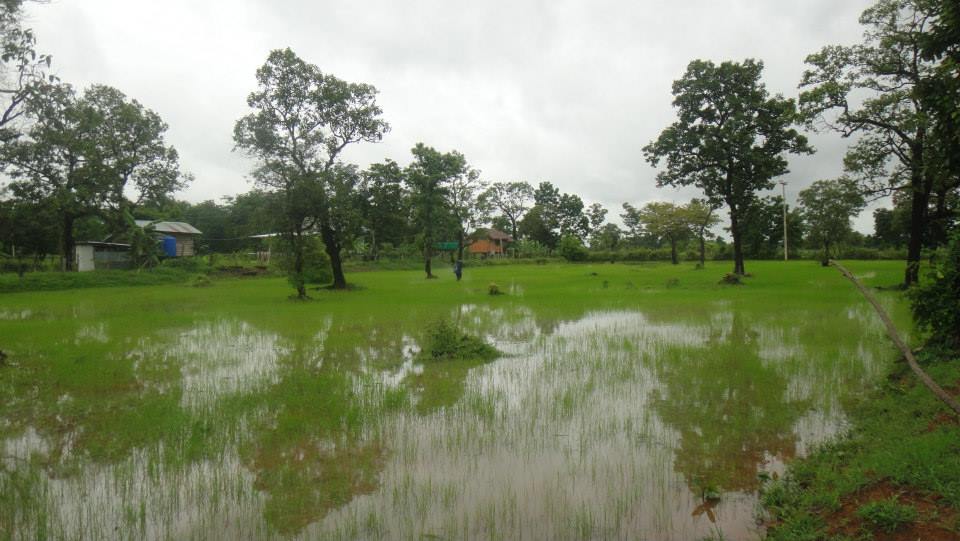
Establishment of seedlings to establish themselves better to sow a dandy. The seeds sown were buried deep in the ground, scattering a quagmire. Sowing is used in the water for about 3-5 cm, and a large tract of land approximately 1-2 acres are converted to a barrier ridge tillage work like preparing the ground for transplanted. The plow in regular furrows for the second time, and the harrow plow roughly for the first time to keep the weeds out of the ground, so it was left to settle until that soil water. The seeds are sown crop to germinate and start planting rice and drain out. Seeds to grow rice and other rice growing. Normally sowing is done in the most.
Chachoengsao Province The second rice crop
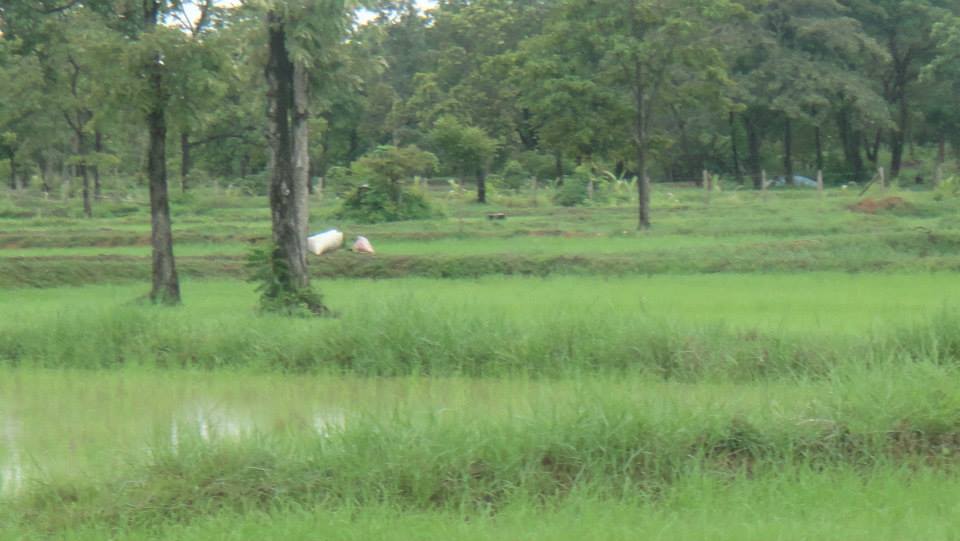
- การดูแลรักษา
ในระหว่างการเจริญเติบโตของต้นข้าว ตั้งแต่การหยอดเมล็ด การหว่านเมล็ด การปักดำต้นข้าวต้องการน้ำและปุ๋ยสำหรับการเจริญเติบโต ในระหว่างนี้ต้นข้าวอาจถูกโรค และแมลงศัตรูข้าวหลายชนิดเข้าทำลายต้นข้าว โดยทำให้ต้นข้าวแห้งตายหรือผลผลิตต่ำและคุณภาพเมล็ดไม่ได้มาตรฐาน เพาะฉะนั้นนอกจากจะมีวิธีการปลูกที่ดีแล้วจะต้องมีวิธีการดูแลที่ดีอีกด้วย ทั้งการกำจัดวัชพืช ใส่ปุ๋ยและพ่นยาเคมี เพื่อป้องกันและกำจัดโรคแมลงศัตรูที่อาจเกิดระบาดขึ้นได้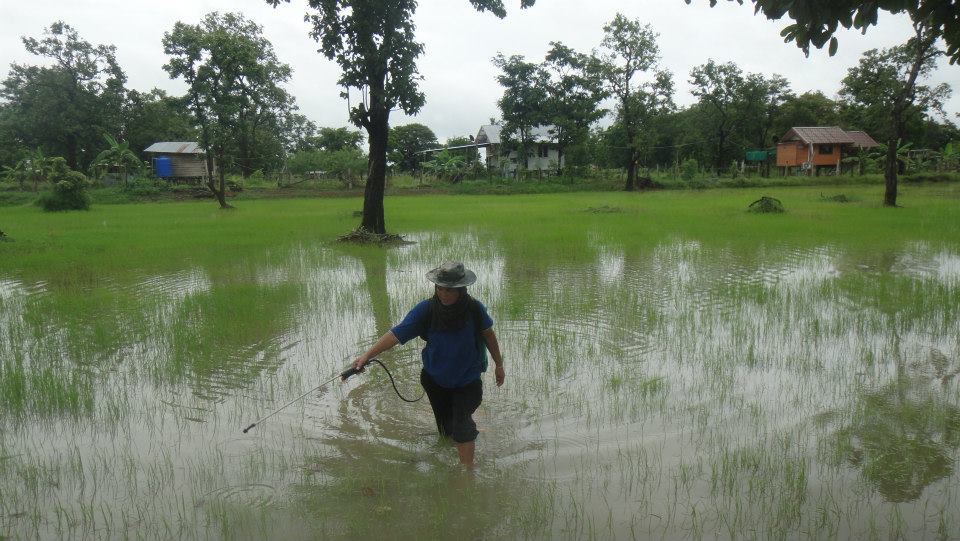
- Maintenance During the growth of crops. Since sowing Sowing The rice crops need water and fertilizer for growth. In the meantime, the rice may be disease.
And several types of rice insect pests destroying crops. By keeping plants die or yield and grain quality is not standard. How to grow a crop that will be a good way to take care of that, too. The weeding Fertilizer and crop chemicals To prevent and eradicate pests that may have caused the outbreak.
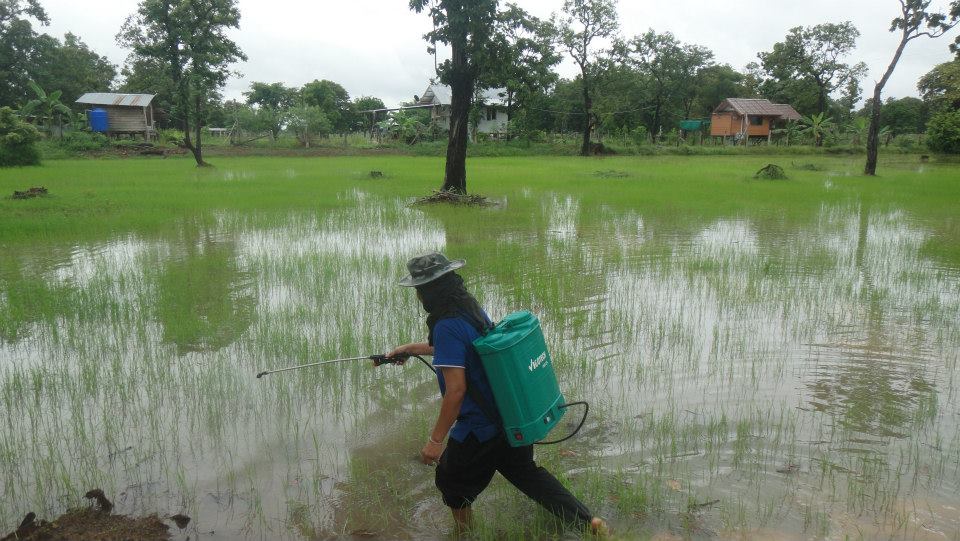
- การเก็บเกี่ยว
สามารถทำได้ในสัปดาห์ที่สี่หลังจากข้าวออกดอกแล้วประมาณ 28-30 วัน ชาวนาภาคเหนือ ภาคตะวันออกเฉียงเหนือ และภาคกลางใช่เคียวสำหรับเกี่ยวข้าวที่ละหลายๆ รวง ส่วนชาวนสภาคใต้ใช้แกระสำหรับเกี่ยวข้าวทีละรวง เคียวที่ใช้เกี่ยวข้าวมี 2 ชนิด ได้แก่ เคียวนาสวน และเคียวนาเมือง เคียวนาสวนเป็นเคียวกว้าง ใช้สำหรับเกี่ยวข้าวนาสวนที่ปลูกไว้แบบปักดำ ส่วนเคียวนาเมืองเป็นเคียววงแคบและมีด้ามยาวกว่าเคียวนาสวน เคียวนาเมืองใช้เกี่ยวข้าวนาเมืองที่ปลูกไว้แบบหว่าน ข้าวที่เกี่ยวด้วยเคียวไม่จำเป็นต้องมีคอรวงยาว เพราะข้าวที่ถูกเกี่ยวมาจะถูกมัดเป็นกำๆ ส่วนข้าวที่ถูกเกี่ยวด้วยแกระจำเป็นต้องมีคอรวงยาวเพราะชาวนาต้องเกี่ยวรวงที่ละรวงแล้วมัดเป็นกำๆ ข้าวที่ถูกเกี่ยวด้วยแกระชาวนาจะเก็บไว้ในยุ้งฉางซึ่งโปร่ง มีอากาศถ่ายเทได้สะดวก และจะทำการนวดเมื่อต้องการขายหรือต้องการสีเป็นข้าวสาร ข้าวที่เกี่ยวด้วยเคียวซึ่งปลูกไว้แบบปักดำ ชาวนาจะทิ้งไว้ในนาบนตอซังเพื่อตากแดดให้แห้งเป็นเวลา 3-5 วัน สำหรับข้าวที่ปลูกแบบหว่านพื้นที่นาจะแห้งในระยะเก็บเกี่ยว ข้าวจึงแห้งก่อนเก็บเกี่ยว ข้าวที่เกี่ยวแล้วจะถูกกองทิ้งไว้บนพื้นที่นาเป็นรูปต่างๆ กันเป็นเวลา 5-7 วัน เช่น รูปสามเหลี่ยม แล้วจึงนำมาที่ลานนวด ข้าวที่นวดแล้วจะถูกนำไปเก็บในยุ้งฉางหรือส่งไปขายที่โรงสีทันทีก็ได้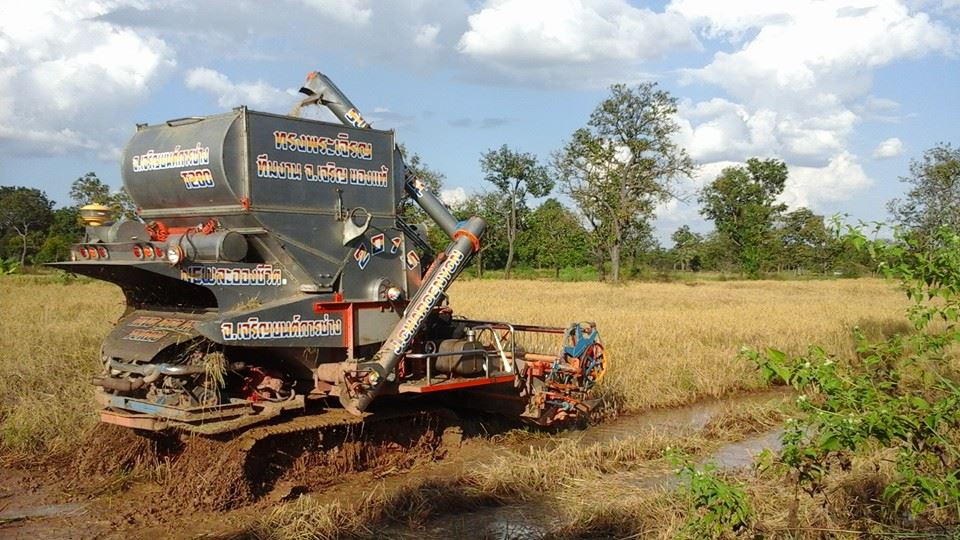
- Harvest Can be done in four weeks, about 28-30 days after flowering of rice in the north east. Central and sickle, for the harvest of multiple grains.
The southern part of the fix for the individual grains harvest. The sickle harvest are two types of sickle and scythe farm farming town. Kure Kure farming is wide Used for farming harvest planted with rice. The town of Kure Kure is narrow and has a long-handled scythe than farming. Paddy rice harvest sickle used in the city planted a sow. The rice with sickles do not need a long Carwg. The rice was about to be tied to a bundle. The rice was associated with the need to solve a long Carwg because farmers have to fall on the ears of a bundle and tied it. Rice was associated with the farmer’s barn, which is kept in the open.
A ventilated And have a massage or want to sell white rice. Rice is planted with a scythe on a black lace. Farmers are left in the stubble fields to dry for 3-5 days. For rice sowing paddy to dry the harvest. Rice is dry before harvest The rice is then pulverized on a farm in the area. 5-7 times a day, like a triangle. Then came the massage area. Massage the rice will be put into storage in the barn or to sell the mill immediately.
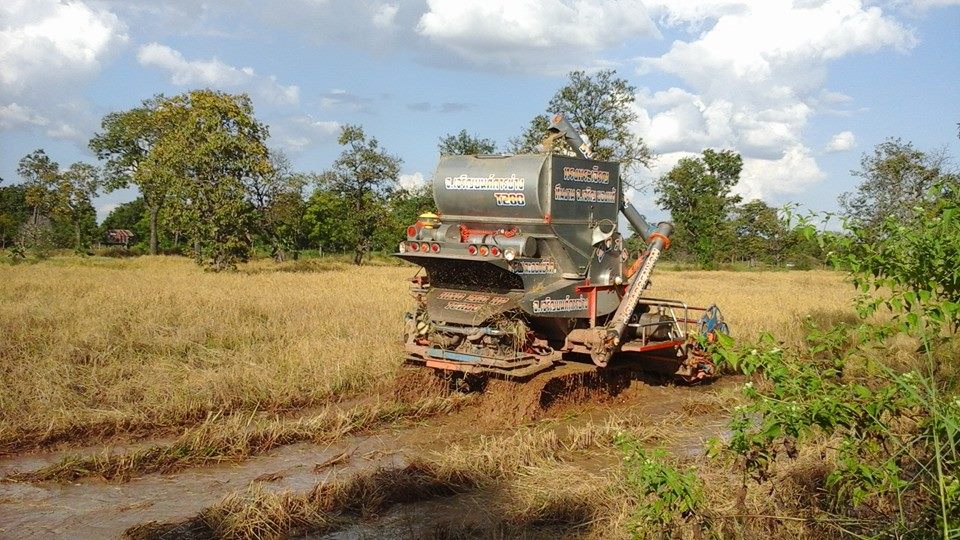
- การนวดข้าว
หมายถึงการนำเมล็ดข้าวออกจากรวงและทำความสะอาด เพื่อแยกเมล็ดข้าวลีบและเศษฟางออก เหลือไว้เฉพาะเมล็ดข้าวเปลือกที่ต้องการเท่านั้น ซึ่งการนวดข้าวสามารถทำได้หลายวิธี เช่น การนวดข้าวโดยใช้แรงสัตว์ (วัว ควาย) การนวดแบบฟาดกำข้าว การนวดแบบใช้เครื่องทุ่นแรง (เครื่องหมุนตีร่วงข้าว) และการนวกแบบใช้เครื่องจักรขนาดใหญ่ (คอมไบน์) โดยเริ่มจากการนำข้าวที่เกี่ยวจากนาไปกองไว้ที่ลานสำหรับนวดข้าว การกองข้าวมีหลายวิธี แต่หลักสำคัญคือการกองข้าวจะต้องเป็นระเบียบ ถ้ากองไม่เป็นระเบียบมัดข้าวะอยู่สูงๆ ต่ำๆ ทำให้เมล็ดข้าวได้รับความเสียหายและคุณภาพต่ำ โดยปกติแล้วจะกองเป็นวงกลม หลังจากข้าวนวดแล้ว ชาวนามักจะที่ตากข้าวให้แห้งเป็นเวลา 5-7 วัน เพื่อลดความชื้นในเมล็ดข้าว ข้าวที่เกี่ยวใหม่ๆ มีความชื้นประมาณ 20-25 % หลังจากตากแล้วเมล็ดข้าวจะมีความชื้นเหลือประมาณ 13-15% เมล็ด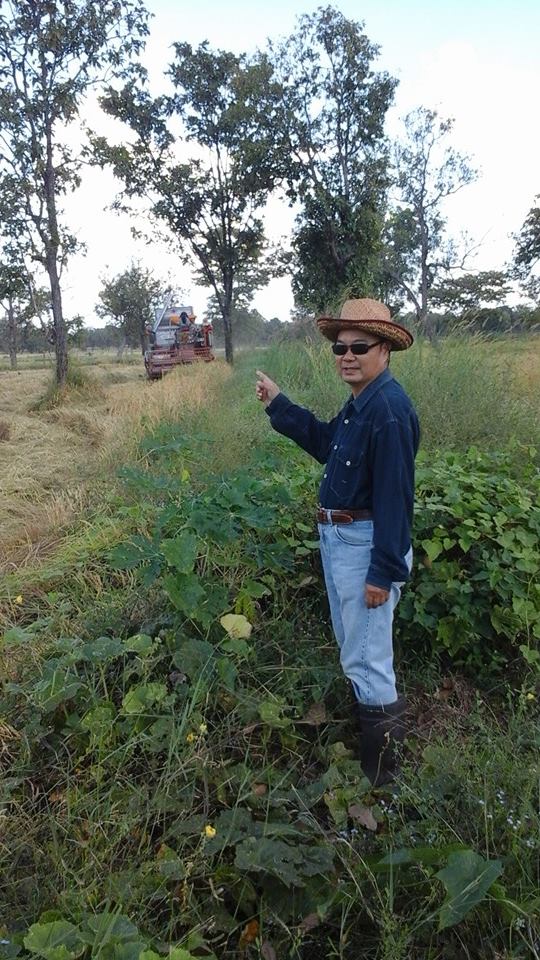
- Combine Means bringing grain from the ears and clean. To separate grain from straw and withered. Leaving only the seed paddy required. The threshing can be done in many ways such as threshing using force animals (cattle) massage overhand grip rice. Massage, using energy-saving tool. (Turners beaten rice) and novices using large machinery (Combinepart).
Beginning with the introduction of rice from paddy to prepare the ground for threshing to stack a number of ways. But the key is to have an orderly stack. If you think a bunch of disorganized pile on the rise.
Making grain was damaged and low quality. Typically, this is a circular mound. After the news, then massage Rice farmers are often exposed to dry for 5-7 days. To reduce the moisture in the grain The new rice Moisture content 20-25 % After drying and grain moisture content to around 13-15% grain.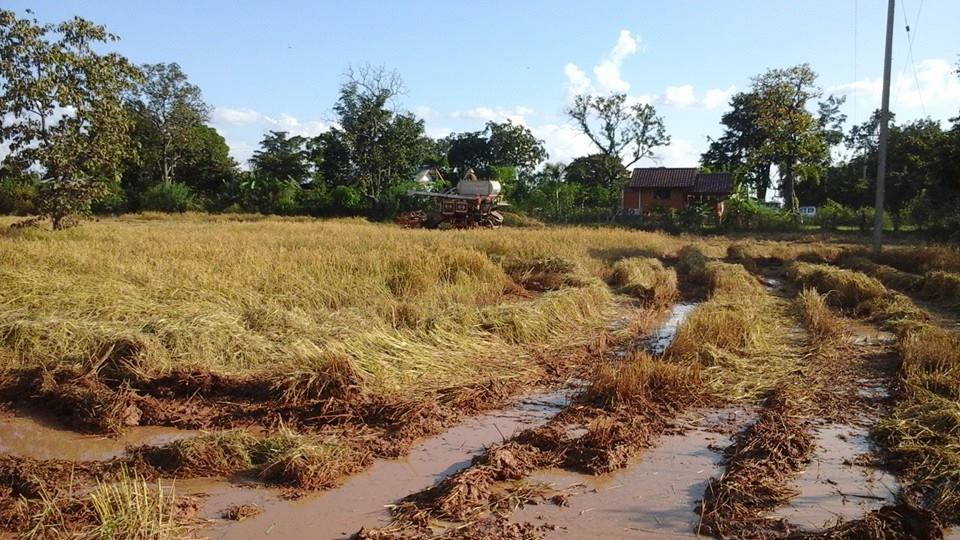
- การทำความสะอาดเมล็ด
เมล็ดข้าวที่ได้จากการนวดมักมีสิ่งเจือปน เช่น ดิน กรวด ทราย เมล็ดลีบฟางข้าวทำให้ขายได้ราคาต่ำ ฉะนั้นชาวนาจะทำความสะอาดเมล็ดก่อนที่จะนำข้าวเปลือกเก็บเข้ายุ้งฉางหรือขายให้พ่อค้า การทำความสะอาดเมล็ด หมายถึง การนำข้าวเปลือกออกจากสิ่งเจือปนอื่นๆ ซึ่งทำได้หลายวิธี เช่น การสาดข้าว การใช้กระด้งฝัด และการใช้เครื่องฝัด
ุุุ6.Clean the seeds Grain of massage often have impurities such as sand, gravel, clay, straw, grain blighted make selling price. Therefore, farmers will seed before bringing grain storage barns or sold to traders. The grain cleaning means Import rice from other impurities. This can be done several ways, such as using a splash of rice threshing grain. And the use of grain
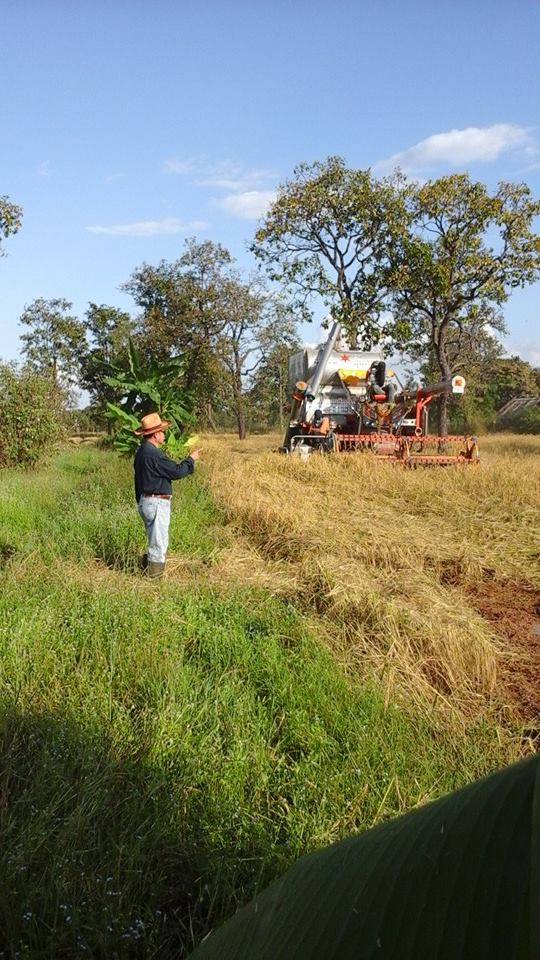
- การตากข้าว
เพื่อรักษาคุณภาพเมล็ดข้าวให้ได้มาตรฐานเป็นเวลานานๆ หลังจากนวดและทำความ สะอาดเมล็ดข้าวแล้ว จำเป็นต้องนำข้าวเปลือกไปตากอีกครั้งหนึ่งก่อนที่จะนำไปเก็บในยุ้งฉาง เพื่อให้ข้าวเปลือกแห้งและมีความชื้นประมาณ 13-15% เมล็ดข้าวในยุ้งที่มีความชื้นสูงกว่านี้จะทำให้เกิดความร้อนสูงจนคุณภาพข้าวเสื่อม และอาจทำให้เชื้อราติดมากับเมล็ดและขยายพันธุ์ทำลายเมล็ดข้าวเปลือกได้เป็นจำนวนมาก การตากข้าวควรตากบนลานที่สามารถแผ่กระจายเมล็ดข้าวให้ได้รับแสงโดยทั่วถึงกัน ควรตากแดดนานประมาณ 3-4 แดด ในต่างประเทศใช้เครื่องอบข้าวเพื่อลดความชื้นในเมล็ดข้าวเรียกว่า Drier โดยให้เมล็ดข้าวผ่านอากาศร้อน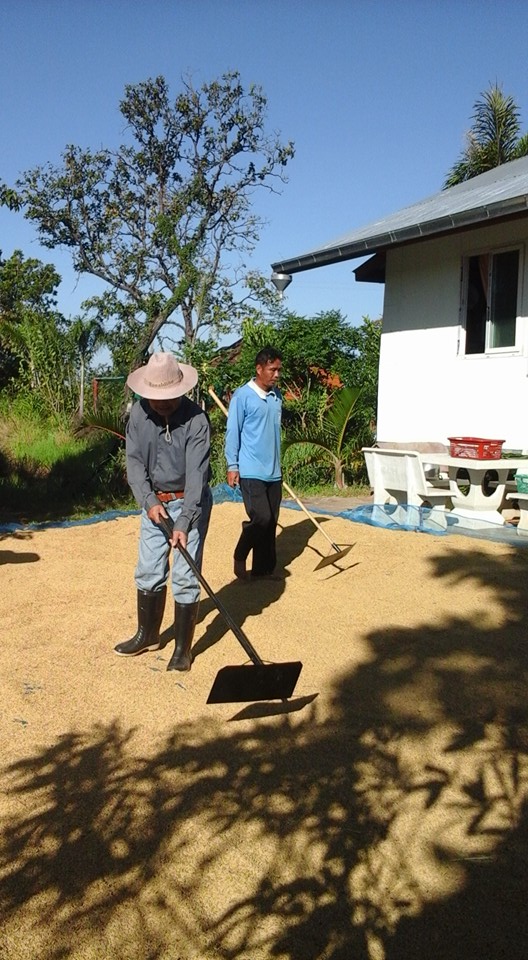
7.dried rice To maintain grain quality standards for a long time. After cleaning and massage Then clean the grain Need to bring paddy to dry again before lead gen in the barn. So that the grain is dry and humidity is around 13-15% grain in the barn, where humidity is higher can cause high heat until rice quality deterioration. And can cause fungal species with seeds and paddy destroyed a lot. The sun should dry rice grains on the patio, which can spread the light evenly to get together. Should the sun for about 3-4 °. Overseas use grain dryers to reduce moisture in the grain by grain through the Drier air.
